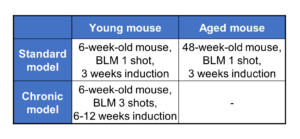Pitfalls of [ disease model mice ] that researchers unknowingly fall into.
In order to evaluate your compound, rather than using a general pulmonary fibrosis model that does not match your pathology, you should use one that allows you to successfully evaluate your desired pathologies. We have seen some cases where this has not been achieved.
The bleomycin-induced pulmonary fibrosis model is commonly used to reproduce the pathology of IPF. However, sometimes the study is conducted by a contractor without the researcher knowing the pathological induction method, duration and endpoints.
When this happens, this is problematic for both the researchers and the contractors and the results can end up being something that neither party wanted.
Evaluating a compound in a short dosing period than planned to see improvement in established fibrosis or using a standard IPF model to improve long-term fibrosis may misidentify the effect or result that was originally intended to be confirmed.
For example, when conducting studies to see the effects of therapeutics such as cell therapies or nucleic acid therapies, a long time period is necessary to accurately examine the efficacy. However, if a short time period study is used, then these types of therapies are administered before the bleomycin is induced, thereby making it a preventative study, rather than the desired therapeutic study. Unfortunately, cases like these are not uncommon.
The following table shows the variety of disease induction periods and mice ages used in IPF studies. Below that are some recommendations on each type.

Young x Standard type:
If you would like to see the effect on pulmonary fibrosis first
Aged x Standard type:
When you would like to use mice with low fibrosis repair capabilities.
Young x Chronic type:
When long-term administration is required, e.g. for cell therapy.
Examples of actual applications and results can be found here.
https://www.smccro-lab.com/news/details.php?news=194
Again, to evaluate your compound, you should use an appropriate pulmonary fibrosis model for evaluation, rather than a common IPF pathology mouse model. To maximize the efficacy of your compound, you should use a pathological mouse model suitable for your desired evaluation, rather than a general model that may not best fit your needs.
To achieve this, you should partner with a non-clinical CRO that can identify your initial objectives and needs and effectively tailor their studies based on that.
We have evaluated many IPF candidates and conducted over 150 efficacy studies using our IPF mouse models.
We would be happy to use our expertise to support you in your research.
